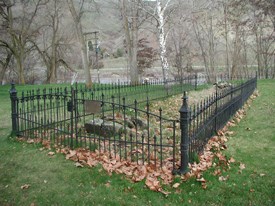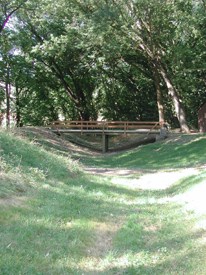
Nez Perce National Historical Park Henry and Eliza Spalding's MissionIn the summer of 1838, Henry Spalding and his wife moved their mission complex and home from five miles up the Lapwai Valley to its present location, where it would remain until 1847 when they fled Nez Perce country in the aftermath of the killing of Marcus and Narcissa Whitman in Walla Walla. The site near Lapwai Creek was cooler during the summer. With help from the Nez Perce, Spalding collected logs and built a home that measured thirty-two feet by twenty-two feet. Over the next ten years, the small modest structure that was built in 1838 gradually expanded to encompass a host of activities that occurred at the mission. Additions were made in 1838, 1841, and 1844 to incorporate a school, printing house, and living space for Nez Perce who worked at the mission and school. After leaving Nez Perce country, the building was used by the Indian agent but they did not preserve the structure. A portion of the building was still standing when Spalding's oldest daughter visited the site in 1884. When she visited again in 1909, the house was gone. In 1923, the Daughters of the American Revolution placed a tablet commemorating the Spalding Mission at the site, and in 1935 they erected an iron fence around the foundations of the Spaldings' home. In 1974, archaeologists from the University of Idaho excavated the site and located the principal building and the subsequent additions made by Spalding. The evidence provides some insight into how Spalding built his complex - quickly and cheaply. The team did not find many artifacts, suggesting that Henry and Eliza did not have many personal possessions. 
Nez Perce National Historical Park The Spaldings' Saw Mill and Grist MillFor generations, the rhythms of Nez Perce life was governed by the seasons - moving to higher elevations in the summer and wintering in the river valleys. This went against Henry Spalding's sensibilities. He wanted his flock to remain near the mission complex year round, raising the food they needed in farms. To accomplish this, he quickly acquired farm implements and, rather than depend upon others to make flour, he took steps to make his own. Beginning in 1839, he enlisted the help of his Nez Perce supporters to build a mill race and canals to irrigate his fields and operate the grist mill. The mill race directed water from Lapwai Creek to the mill, a distance of a half mile. In the spring of 1838, the granite for grind stones was found up the Clearwater River near the present site of Dworshak Dam. Spalding began to process his own flour after the grindstones were completed, in the late spring of 1840. In tandem with the grist mill was a sawmill. The mill was in sporadic operation and dismantled in 1846. The Memorial GroveWhen Spalding built his mission here in 1838, the site was barren of trees. The current appearance of the historic area is one of the legacies of the centennial anniversary of the Spalding's arrival in the Lapwai Valley. After placing a memorial to the Spalding mission and fencing off the remains of Spalding's home, the Daughters of the American Revolution lobbied to have the state create a park preserving the mission site, which occurred in 1936. Following the state's action, the Idaho Bureau of Highways landscape engineer, W.S. Thornber, designed a memorial grove of trees, plans and shrubs from across North America and Europe. Of the original thirty-five species of trees planted, twenty-two remain including several oak, spruce, and pine varieties, and even a sequoia. Sources
|
Last updated: April 29, 2023
